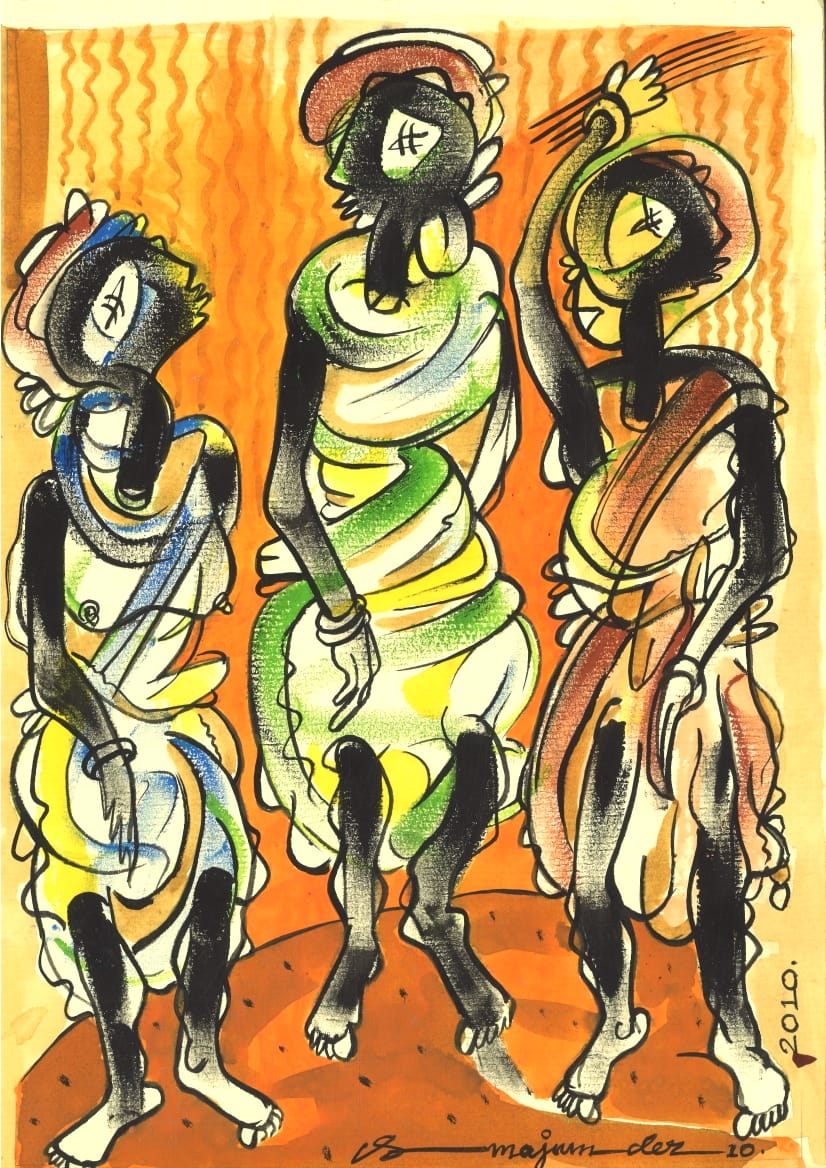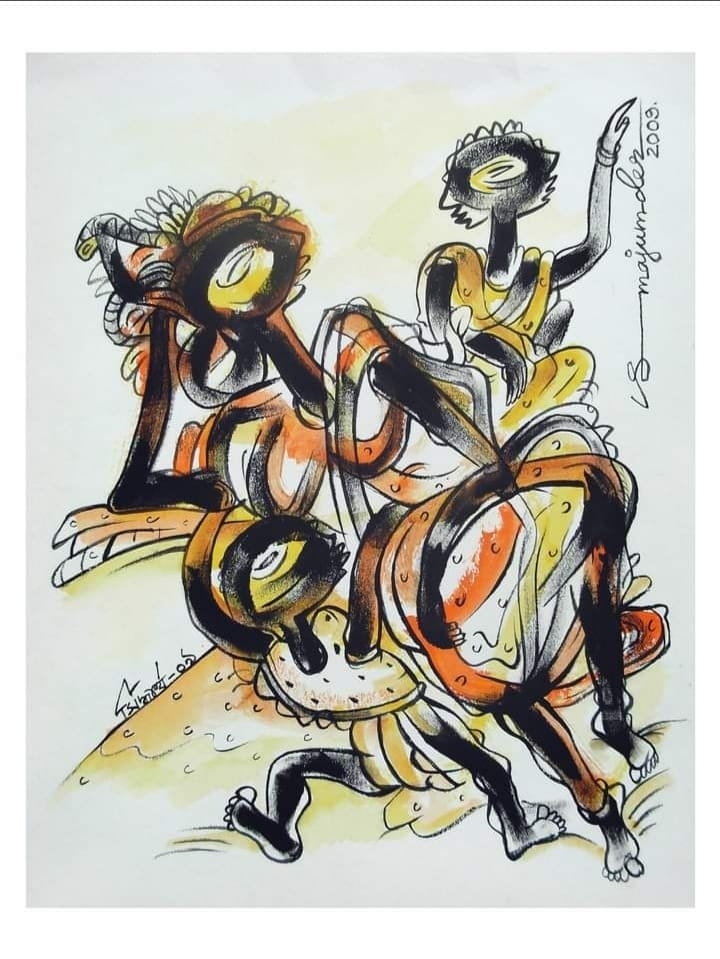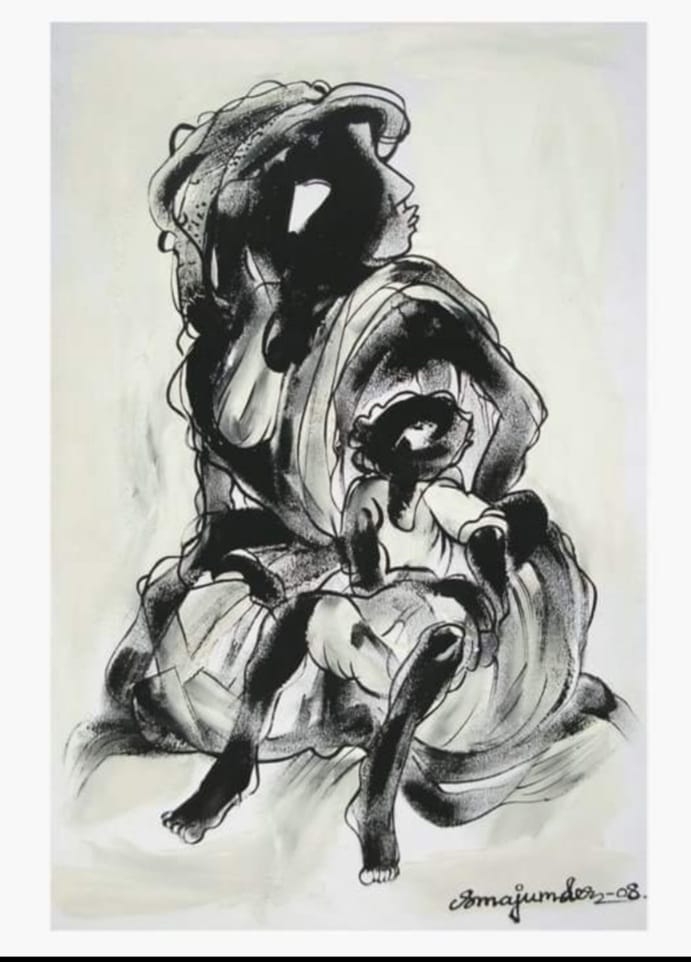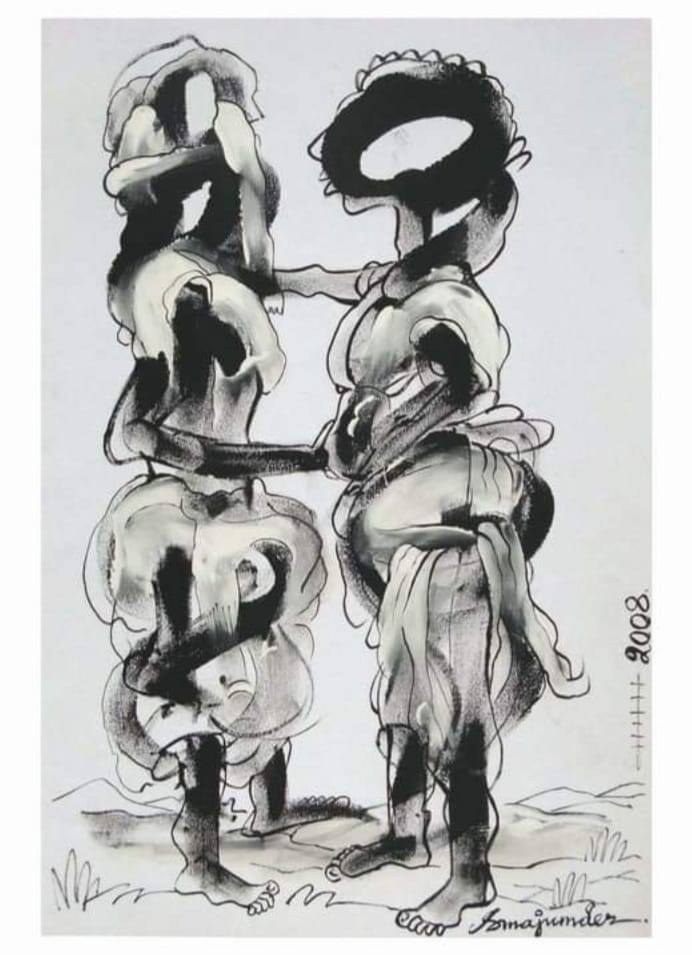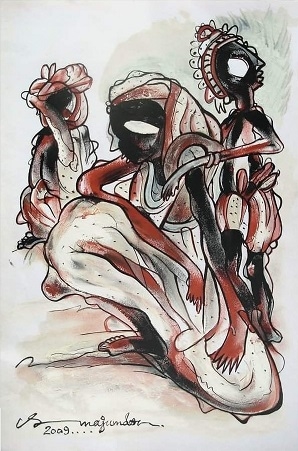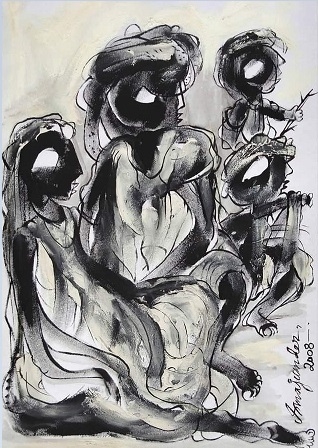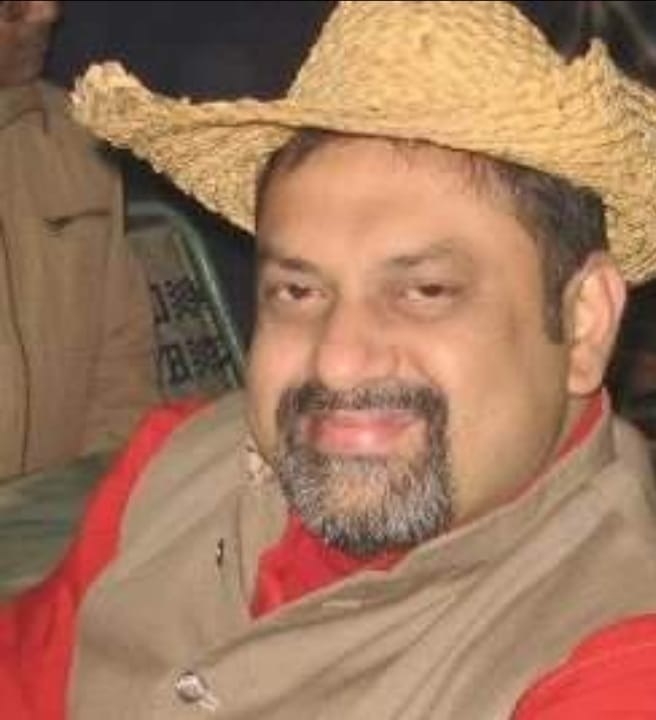
Siddhartha Majumder
ARTIST OF "KOLKATA"
Siddhartha Majumder (Partha) , growing up in a renowned and very well to do family of Santiniketan , India. He imbibed the cultural heritage that the environs of Santiniketan offered to the Ashramiks. He has that very essential quality and flair of giving expressions to his creative urge that the “Santiniketan – education” imparts on everyone who has the inclination.
The Majumder family was established in Tagore’s Santiniketan by his great grandfather Shrish Chandra Majumder, a District Magistrate by profession and a consort of Tagore in the latter’s endeavour in building the Santiniketan Brahmacharya Ashram. Shrish Chandra’s son Santosh Chandra Majumder - the first direct Disciple of Noble Laureate Rabindranath Tagore in Santiniketan , as well as he was one of the first four boys, whom Tagore opted along with his son Rathindranath Tagore to the first batch of student for his experimental and holistic school “BRAMHA CHARJYA ASHRAM” in the land of Santiniketan .Later Tagore sent his intellectual friend - Shrish Chandra’s son Santosh Chandra Majumder (Siddhartha’s Grandfather) and his own son Rathindranath Tagore to “Illinois University” in USA for their higher educations of Agricultural Science & Technology. In the year of 1904 - during that period , they were the first Indian students from India , those were studying as foreign students at “Illinois University” in USA . After completed his higher education from “Illinois University” of USA , Santosh Chandra came back to India and introduced the importance for the application of Science & Technology in the farming sector of Indian society and for the better result of Agricultural productions also . He was always very much fond of the Tribal and Rural life of India . Santosh Chandra always believed that the rural development is one of the most important parts , for the progress of our nation.
MAKING OF THE ARTIST AND HIS CREATION :-
Siddhartha also belongs to the student of this renowned “Viswa Bharati University” of Tagore’s land , in “Santiniketan” from his childhood. He was educated in Patha Bhavana school to Kala Bhavana Art College in Santiniketan . He completed his course of Kala Bhavana art college (with Honours Degree) in the year of 1991. He is a true disciple of great Indian artists as well as the legendary professor of renowned Kala Bhavana art college , Santiniketan . Like –MR.K.G.SUBRAMANIUM ; MR. JOGEN CHOUDHURY ; MR. SUHAS ROY ; MR.LALU PRASAD SHAW ; MR. SELIM MUNSI ; MR. RITEN MAZUMDER ; MR. NANI GOPAL GHOSH ; MR. PRANAB KUMAR ROY – etc . These Masters are the real inspirations of his journey of creative world now .Today Siddhartha’s art works are in several private collections in India and Abroad too.
NATURE OF WORK : -
Siddhartha likes to work with expressions of the Human and Nature forms in obstructions and the energy derived from that . This motion comes from the source of human reserve of the mind , which is reflected in respective expressions in his work . Human and Nature forms are always in the centre point of his paintings . The pulse and rhythm of his art comes from a filial affinity to nature and milieu . Like his grand father , Siddhartha is also very much fond of the Tribal and Rural life of India. By his birth - he got the opportunity to observe the Tribal and Rural life from the surroundings of his childhood, very closely and minutely in Santiniketan . Where the human and nature are almost inseparable elements of the life . His personality grow up in Santiniketan from grew in direct interaction with the different seasonal nature and the facts around . So that he had been deeply influenced by the nature and the original life of Santali tribels with their simplicity , expressions , honesty , peaceful family life, rituals of their life, social bonding , art and culture , etc . When Siddhartha likes to work with expressions of the Human and Nature forms , then all the above impressions come in his subconscious mind and then he started his creative work from a very quiet place of his heart and after that ha was expending his imagination . His aim to capture this energy through the expressions and reveal it through his art . A posture only captures a fraction of the movement , but the expressions reveal the complete movement – BODY ; MIND & SOUL . Siddhartha is continuouslymaking a choice of portraying – what is the only positivity in our life . His work is that his "people" are directly from our real life and they are very much expressive . The person feels familiar to the viewer but it is far more individualised - the face is imaginary but the psyche or characteristics are real. The power and beauty of his technique and line is this play between the known and unknown .
In Siddhartha’s work , the figure is always in the foreground, it is primary, it conveys everything . He uses colour to give volume to his figures and the fluidity of his lines bring a sensual aspect to his forms. Majumder’s ability to juxtapose contrary emotions, the real and imaginary and the known and unknown, make his art not only a form of self expression but a reflection, of a collective and subjective consciousness.
ARTIST OF "KOLKATA"
Siddhartha Majumder (Partha) , growing up in a renowned and very well to do family of Santiniketan , India. He imbibed the cultural heritage that the environs of Santiniketan offered to the Ashramiks. He has that very essential quality and flair of giving expressions to his creative urge that the “Santiniketan – education” imparts on everyone who has the inclination.
The Majumder family was established in Tagore’s Santiniketan by his great grandfather Shrish Chandra Majumder, a District Magistrate by profession and a consort of Tagore in the latter’s endeavour in building the Santiniketan Brahmacharya Ashram. Shrish Chandra’s son Santosh Chandra Majumder - the first direct Disciple of Noble Laureate Rabindranath Tagore in Santiniketan , as well as he was one of the first four boys, whom Tagore opted along with his son Rathindranath Tagore to the first batch of student for his experimental and holistic school “BRAMHA CHARJYA ASHRAM” in the land of Santiniketan .Later Tagore sent his intellectual friend - Shrish Chandra’s son Santosh Chandra Majumder (Siddhartha’s Grandfather) and his own son Rathindranath Tagore to “Illinois University” in USA for their higher educations of Agricultural Science & Technology. In the year of 1904 - during that period , they were the first Indian students from India , those were studying as foreign students at “Illinois University” in USA . After completed his higher education from “Illinois University” of USA , Santosh Chandra came back to India and introduced the importance for the application of Science & Technology in the farming sector of Indian society and for the better result of Agricultural productions also . He was always very much fond of the Tribal and Rural life of India . Santosh Chandra always believed that the rural development is one of the most important parts , for the progress of our nation.
MAKING OF THE ARTIST AND HIS CREATION :-
Siddhartha also belongs to the student of this renowned “Viswa Bharati University” of Tagore’s land , in “Santiniketan” from his childhood. He was educated in Patha Bhavana school to Kala Bhavana Art College in Santiniketan . He completed his course of Kala Bhavana art college (with Honours Degree) in the year of 1991. He is a true disciple of great Indian artists as well as the legendary professor of renowned Kala Bhavana art college , Santiniketan . Like –MR.K.G.SUBRAMANIUM ; MR. JOGEN CHOUDHURY ; MR. SUHAS ROY ; MR.LALU PRASAD SHAW ; MR. SELIM MUNSI ; MR. RITEN MAZUMDER ; MR. NANI GOPAL GHOSH ; MR. PRANAB KUMAR ROY – etc . These Masters are the real inspirations of his journey of creative world now .Today Siddhartha’s art works are in several private collections in India and Abroad too.
NATURE OF WORK : -
Siddhartha likes to work with expressions of the Human and Nature forms in obstructions and the energy derived from that . This motion comes from the source of human reserve of the mind , which is reflected in respective expressions in his work . Human and Nature forms are always in the centre point of his paintings . The pulse and rhythm of his art comes from a filial affinity to nature and milieu . Like his grand father , Siddhartha is also very much fond of the Tribal and Rural life of India. By his birth - he got the opportunity to observe the Tribal and Rural life from the surroundings of his childhood, very closely and minutely in Santiniketan . Where the human and nature are almost inseparable elements of the life . His personality grow up in Santiniketan from grew in direct interaction with the different seasonal nature and the facts around . So that he had been deeply influenced by the nature and the original life of Santali tribels with their simplicity , expressions , honesty , peaceful family life, rituals of their life, social bonding , art and culture , etc . When Siddhartha likes to work with expressions of the Human and Nature forms , then all the above impressions come in his subconscious mind and then he started his creative work from a very quiet place of his heart and after that ha was expending his imagination . His aim to capture this energy through the expressions and reveal it through his art . A posture only captures a fraction of the movement , but the expressions reveal the complete movement – BODY ; MIND & SOUL . Siddhartha is continuouslymaking a choice of portraying – what is the only positivity in our life . His work is that his "people" are directly from our real life and they are very much expressive . The person feels familiar to the viewer but it is far more individualised - the face is imaginary but the psyche or characteristics are real. The power and beauty of his technique and line is this play between the known and unknown .
In Siddhartha’s work , the figure is always in the foreground, it is primary, it conveys everything . He uses colour to give volume to his figures and the fluidity of his lines bring a sensual aspect to his forms. Majumder’s ability to juxtapose contrary emotions, the real and imaginary and the known and unknown, make his art not only a form of self expression but a reflection, of a collective and subjective consciousness.

